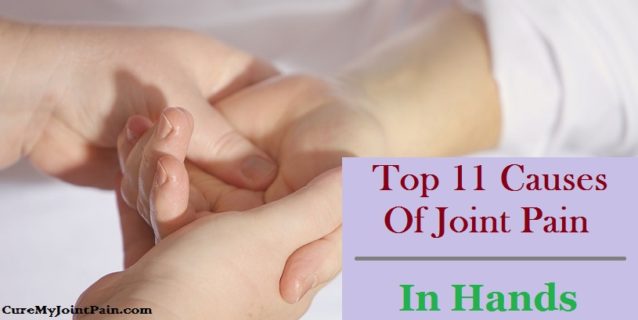Top 11 Causes Of Joint Pain In Hands (+ How To Recognize Them)

Joint pain is surely a frustrating problem – especially if it’s affecting your hands:
- It makes you feel like you’re losing your strength and independence
- Every activity becomes difficult
But what’s causing that pain? Is it a real condition or it’s just a symptom of something more complex?
It’s time to dig deep into the problem. Here are 11 of the most common causes of joint pain in hands.
To tell you honestly – there are around 95% chances that you pain is caused by one of these conditions, so don’t ignore any!
#1 – Arthritis
Now – every person with joint pain suspects having arthritis. But surprisingly – it’s not always the responsible.
Yes, it is indeed the #1 cause for joint pain in hands, but it’s overestimated sometimes.
Arthritis comes in so many forms, but 2 of them are major:
- Auto-immune forms – which includes rheumatoid, juvenile and psoriatic arthritis .
- Osteoarthritis – that affects around 12% of the over 60 population.
How To Recognize It: There’s no clear symptom, but besides the pain there is also:
- Stiffness in the morning or after getting up
- Little flexibility
- Sometimes cartilage damage
Most of the times – arthritis starts by affecting the hand joints.
What To Do About It: Fortunately, there are some good news. Arthritis is quite easy to diagnose, compared to other diseases:
- Autoimmune forms can be spotted in regular blood tests
- Osteoarthritis can usually be revealed by radiography
So a simple investigation could tell if arthritis is making your hands hurt.
If it is – supplements can help a lot on the long term.
#2 – Infections
That’s a cause of joint pain that no one speaks about.

It’s pretty rare – that’s true. But quite a few people have had joint infections throughout the years.
How To Recognize It: Compared to arthritis, it’s easier:
- Your pain appears out of a sudden, usually at night
- You also have fever
Moreover, if you’ve been through a surgery in the last months – it’s pretty sure it’s an infection behind.
Bacterias like Streptococcus aureus or Neisseria gonorheae literally love the joints.
So if they get inside your body, there are high chances that they produce a joint infection.
What To Do About It: There’s one simple solution to infections – antibiotics. They work within days – so the pain should go away pretty fast.
#3 – Tendinitis
What exactly is tendinitis? It’s simple – the inflammation of tendons, some tissues that are located close the the joints.
The interesting part? Tendinitis doesn’t affect the joints themselves.
But you can’t really tell that from the outside – the pain feels like any other.
How To Recognize It: In this case, it’s pretty hard:
- Usually appears to athletes, dancers or active people
- The painful part also feels warm and swollen
Basically – you can get tendinitis if you recently did a physical effort.
What To Do About It: Most of the times, tendinitis heals alone.
Here’s what you can do to speed up your recovery:
- Rest and give up any physical effort
- Use a pain-relieving cream
Also – make sure you visit your doctor.
Not only that he can diagnose tendinitis easily – but he can also prescribe you additional medication (like NSAIDs).
But here’s some good news – hand tendinitis is pretty rare. So unless you’re a huge gym fan, it’s probably not the responsible for your hand pain.
4. Carpal Tunnel Syndrome
Just like tendinitis, Carpal Tunnel Syndrome doesn’t affect the joints themselves.
However – you can’t really make the difference between this pain and a regular joint pain.
How To Recognize It: Basically, this condition affects the nerve responsible for your finger movement.
For this reason – here’s how you can spot it:
- You also have stiffness, besides the pain
- Your fingers feel swollen but they look perfectly normal
What To Do About It: Here’s some good news – this condition can be easily diagnosed.
All you need is an X-ray and your doctor can tell if it’s Carpal Tunnel Syndrome or not:
- In easy forms resting is enough.
- In severe cases you might need some minor surgery.

#5 – Lupus
In case you never heard of it – lupus is an autoimmune disease that can also affect the joints.
How To Recognize It: Just like the RA, lupus starts with joint pain and stiffness.
In fact many times, patients can experience pain just in their hand joints.
But the pain is always combined with other signs:
- fever
- fatigue
- the typical butterfly rash on the check
So if you have any of these additional signs – consult a doctor immediately. You’re might have an initial form of lupus.
But here’s the interesting part:
- Lupus doesn’t always affect the joints.
- Some people may not have any minor joint pain.
- In others, it can disappear as the disease progresses.
What To Do About It: Medical treatment is a must in this case.
The symptoms are very different from person to person, but the treatment is still essential.
Besides, if your lupus is affecting your joints – you can also try some alternative treatments that work for RA.
#6 – Trigger Finger
In case you heard of stenosing tenosynovitis – it’s the same thing.

Basically – that’s another problem that affects the tendons, not the joints themselves. But you can’t really tell that from the outside.
How To Recognize It: Let’s take a look at what’s causing this problem.
- It’s the tendon sheaths that get inflamed.
- These sheaths are similar to some tunnels.
- Every time your finger moves, the tendons go through these tunnels and back.
But what happens if these tunnels are inflamed? It’s simple:
- the tendons don’t have enough room to get through
- your finger gets stuck.
That’s where the stiffness and pain come from.
So basically – your affected finger feels painful, stiff and hard to move.
What To Do About It: Fortunately, this condition is also quite easy to diagnose with an X-ray.
Treatment is pretty basic as well, at least in easier forms.
#7 – Fibromyalgia
Basically, fibromyalgia is a neurological disease. So what’t that special about it?:
- It changes the pain receptors throughout your body
- In other words, it amplifies every painful sensation
In fibromyalgia, a minor pain feels much worse than it should normally feel.
How To Recognize It: This condition doesn’t have a major symptom.
It’s actually a combination of signs that would help your doctor spot it:
- It starts with sudden joint pain (especially in the hands).
- The pain then spreads to other muscles, joints and bones.
- There’s also excessive sleepiness and memory loss.
- It usually appears after a trauma or stressful episode.
But unfortunately, diagnosing fibromyalgia is no easy thing. Blood tests and X-rays show nothing wrong.
What To Do About It: There aren’t any great news. At this point:
- there’s no treatment that can cure fibromyalgia
- there are lots of drugs and pain killers
- but they come with serious side effects
My top recommendation is turmeric, which is a natural anti-inflammatory.
It decreases the pain better than any other herb and it has some minor side effects. That’s why many people with fibromyalgia use it constantly.
#8 – Polimyalgia
Though it has a similar name – polimyalgia is totally different from fibromyalgia.
How To Recognize It: It’s not very easy. The symptoms it causes are pretty common as in other conditions:
- sudden pain
- stiffness in hands, shoulders and neck
- It’s usually associated with temporal arthritis
But the truth is – polimyalgia isn’t a very common disease, so genetics play a big part in its development.
Besides, the average age is around 70.
What To Do About It: Fortunately, the prognosis is pretty good.
Unlike arthritis or fibromyalgia – polimyalgia can be cured after longer periods of treatment. So make sure you see your doctor for the best treatment.
#9 – Gout
In the past centuries, gout was considered the disease of wealthy people. The reason?
It’s caused by large amounts of uric acid in the blood. Or in other words – by a diet rich in meat and alcohol.
How To Recognize It: This time, it’s pretty easy.
Gout is actually a particular type of inflammatory arthritis:
- In more than 50% cases, it affects the toe joint.
- The pain usually appears during the night and it’s atrocious.
- It feels like your toes are burning alive.
Basically – the pain from gout is the worst among all forms of arthritis. That’s the best sign to recognize it.
Now – gout usually affects the toes.
But in some cases, it can also affect the fingers – especially if you are overweight and have a family history of gout.
What To Do About It: Surprisingly, gout is easier to treat than other forms of arthritis.
There are both modern and natural therapies now – from drugs like NSAIDs to herbs like Devil’s Claw.
Besides, diagnosing the disease in quite simple with blood tests and X-rays.
#10 – Sprains Or Injuries
It may sound hard to believe – but your hand joint pain can have a silly cause.
In fact, studies revealed that sprains and injuries are the #2 cause of joint pain in hands. Arthritis stands as the first.
How To Recognize It: There’s no clear pattern for this problem.
- Try to remember when your pain started.
- Figure out if you had any accident in the days before.
Now – if your injury was minor, maybe you weren’t even aware of it.
What To Do About It: If you suspect a minor accident caused your pain, visit a doctor.
If there’s any sprain or injury, it should be visible using the X-rays.
#11 – Side Effects Of Drugs
Surprisingly, there are numerous medicines that can lead to temporary joint pain.
Anti cancer drugs are the #1 responsible for this kind of pain:
- Paclitaxel
- Bleomycin
- Cladribine
- L-asparaginase
These are just the most common drugs, but there are many others.
Also, antibiotics like fluoroquinolones can lead to tendinitis – which can cause pain in your hand joints.
How To Recognize It: There’s no major criteria, but usually – your pain should begin soon after you started the treatment.
What To Do About It: First of all, let your doctor know about it.
If your disease affords it, your treatment will be changed.
Otherwise – you will probably be prescribed an additional treatment that will stop the pain and protect your joints.
So What’s Causing Your Hand Joint Pain?
If you’re still unsure about what’s causing that terrible pain in your hand joint, here are a few things to start from:
1. Your Health In The Last 3 Months
Have you followed any medical treatment lately?
Have you been through any surgery?
Or have you been diagnosed with any other condition?
2. Your Family History
Does anyone from your family have joint pains as well?
Has any of your relatives been diagnosed with an autoimmune disease?
3. Your Workplace
Does your job require an extra use of your hands/fingers?
Did you have any recent hand injury at work?
4. Your Symptoms
Does your joint pain come alone?
Do you feel this pain just in your hands – or in other joints as well?
Have you had any fever lately?
Answer each of these questions and write down any positive answer.
Now – that’s not a sure way to diagnose your problem, but it’s a start. So it can surely help you get an idea about what you’re suffering of.
Once you suspect what’s the problem, the best thing you can do is to consult a doctor:
- you will have your tests done
- and you will get a clear diagnosis
Even if you have a mere infection or a harder-to-treat condition, medical treatment will solve your pain.






I really loved your blog. I’ve been looking for some source that would give me as many causes for joint pain in hands as I could wish for. I’m doing my degree on a similar topic so I need lots of information.
Now, I don’t know much about joint pain as a patient because I’ve never experienced it. But as a reader, I do, or rather I thought I did, before finding your website. You know so much it’s almost impossible to argue with you (not that I actually would want, haha). I’m bookmarking your site for future references. Great stuff, just great!
Hi Sary, thank you so much for your kind words. I’m so happy to help, even if it’s only people who need informative things. If there’s any joint related info that you need, please let me know.